新人教版七年级上册英语教案-Unit1 (1)
人教版(2024年)七年级上册Unit 1 You and Me 单元整体教学设计
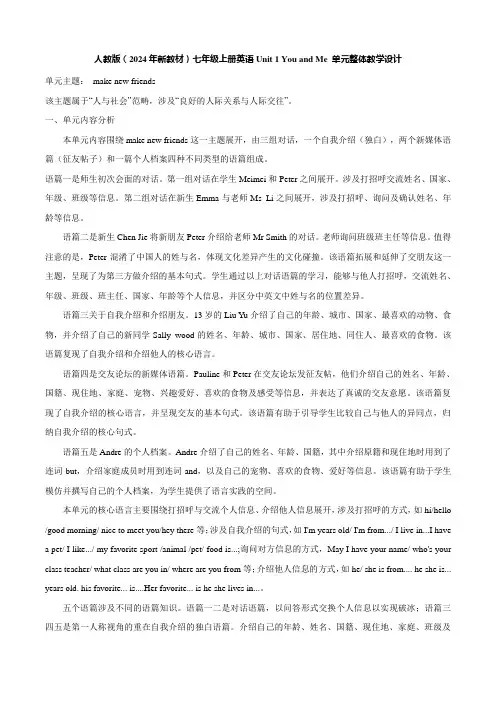
人教版(2024年新教材)七年级上册英语Unit 1 You and Me 单元整体教学设计单元主题:make new friends该主题属于“人与社会”范畴,涉及“良好的人际关系与人际交往”。
一、单元内容分析本单元内容围绕make new friends这一主题展开,由三组对话,一个自我介绍(独白),两个新媒体语篇(征友帖子)和一篇个人档案四种不同类型的语篇组成。
语篇一是师生初次会面的对话。
第一组对话在学生Meimei和Peter之间展开。
涉及打招呼交流姓名、国家、年级、班级等信息。
第二组对话在新生Emma与老师Ms Li之间展开,涉及打招呼、询问及确认姓名、年龄等信息。
语篇二是新生Chen Jie将新朋友Peter介绍给老师Mr Smith的对话。
老师询问班级班主任等信息。
值得注意的是,Peter混淆了中国人的姓与名,体现文化差异产生的文化碰撞。
该语篇拓展和延伸了交朋友这一主题,呈现了为第三方做介绍的基本句式。
学生通过以上对话语篇的学习,能够与他人打招呼,交流姓名、年级、班级、班主任、国家、年龄等个人信息,并区分中英文中姓与名的位置差异。
语篇三关于自我介绍和介绍朋友。
13岁的Liu Yu介绍了自己的年龄、城市、国家、最喜欢的动物、食物,并介绍了自己的新同学Sally wood的姓名、年龄、城市、国家、居住地、同住人、最喜欢的食物。
该语篇复现了自我介绍和介绍他人的核心语言。
语篇四是交友论坛的新媒体语篇。
Pauline和Peter在交友论坛发征友帖,他们介绍自己的姓名、年龄、国籍、现住地、家庭、宠物、兴趣爱好、喜欢的食物及感受等信息,并表达了真诚的交友意愿。
该语篇复现了自我介绍的核心语言,并呈现交友的基本句式。
该语篇有助于引导学生比较自己与他人的异同点,归纳自我介绍的核心句式。
语篇五是Andre的个人档案。
Andre介绍了自己的姓名、年龄、国籍,其中介绍原籍和现住地时用到了连词but,介绍家庭成员时用到连词and,以及自己的宠物、喜欢的食物、爱好等信息。
2024新人教七年级英语上册 Unit 1 You and Me(大单元教学设计)
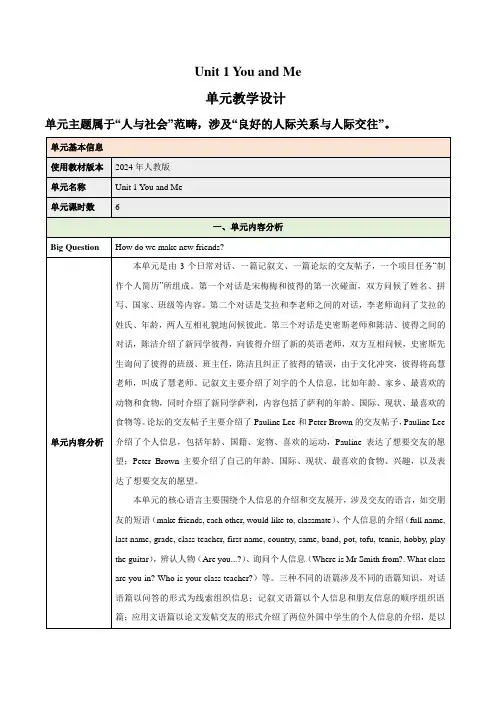
(1)元音字母组合ea/ee/ea的发音;
(2)特殊疑问句回答时主语的用法;
(3)随着主语数量的变化,be动词的用法。
2.语言技能方面
(1)在听说活动中,部分学生还不能快速准确的获取信息;不能主动、准确进行表达;
(2)在读写活动中,部分学生不能快速归纳与不同对象展开对话所用语言的差异;不能准确的进行书写。
(二)学业质量分析:
1.能听懂相关主题的语篇,借助关键词句、图片等复述语篇内容。
2.能选用正确的词语,通过口语语篇描述,介绍人和事物。
3.能参照范例,仿写简单的文段,语言准确,表意得体。
4.朗读相关主题的简短语篇时,连续、停顿自然,语音、语调基本正确。
5.能根据口头交际的具体语境,初步运用得体的语言形式,表达自己的情感、态度和观点。
本单元的核心语言主要围绕个人信息的介绍和交友展开,涉及交友的语言,如交朋友的短语(make friends, each other, would like to, classmate)、个人信息的介绍(full name, last name, grade, class teacher, first name, country, same, band, pot, tofu, tennis, hobby, play the guitar),辨认人物(Are you...?)、询问个人信息(Where is Mr Smith from?. What class are you in? Who is your class teacher?)等。三种不同的语篇涉及不同的语篇知识,对话语篇以问答的形式为线索组织信息;记叙文语篇以个人信息和朋友信息的顺序组织语篇;应用文语篇以论文发帖交友的形式介绍了两位外国中学生的个人信息的介绍,是以网页截图的形式呈现。
2024年人教版七年级上册英语unit1教案
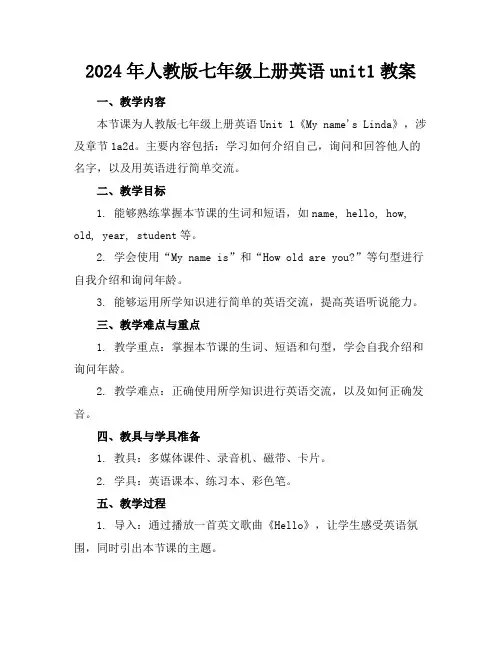
2024年人教版七年级上册英语unit1教案一、教学内容本节课为人教版七年级上册英语Unit 1《My name's Linda》,涉及章节1a2d。
主要内容包括:学习如何介绍自己,询问和回答他人的名字,以及用英语进行简单交流。
二、教学目标1. 能够熟练掌握本节课的生词和短语,如name, hello, how, old, year, student等。
2. 学会使用“My name is”和“How old are you?”等句型进行自我介绍和询问年龄。
3. 能够运用所学知识进行简单的英语交流,提高英语听说能力。
三、教学难点与重点1. 教学重点:掌握本节课的生词、短语和句型,学会自我介绍和询问年龄。
2. 教学难点:正确使用所学知识进行英语交流,以及如何正确发音。
四、教具与学具准备1. 教具:多媒体课件、录音机、磁带、卡片。
2. 学具:英语课本、练习本、彩色笔。
五、教学过程1. 导入:通过播放一首英文歌曲《Hello》,让学生感受英语氛围,同时引出本节课的主题。
2. 新课展示:展示多媒体课件,呈现本节课的生词、短语和句型,引导学生跟读并模仿。
3. 例题讲解:以PPT形式展示例题,讲解如何用英语进行自我介绍和询问年龄,并引导学生进行实际操作。
4. 随堂练习:发放练习纸,让学生两人一组进行角色扮演,练习自我介绍和询问年龄。
5. 小组活动:将学生分成若干小组,进行“Find your partner”的游戏,要求学生用英语进行交流,找到与自己年龄相仿的伙伴。
六、板书设计1. Unit 1 My name's Linda2. 生词:name, hello, how, old, year, student等3. 句型:My name is How old are you? I'm七、作业设计1. 作业题目:(1)抄写本节课的生词、短语和句型,每个三遍。
(2)用英语写一篇自我介绍,包括姓名、年龄和兴趣爱好。
新人教版七年级英语上册unit1第一课时教案

①My name is Ye Fan.
②I'm Zhang Xingyu.
环节说明:通过课前的一个自我介绍活动激发学生说英语的热情,让学
生了解用英文介绍自己的方法,从而导入新课话题。
Step 2 完成教材 1a~1c 的任务
【操作案例】
1.认真观察 1a 图片,由三位学生参加单词拼写比赛,看谁写得又对又
nice to meet you.”,答语常用“Nice to meet you,too.”。
§当堂评价方案(详见当堂训练部分)
板书设计
(手写) 教学反思
教研组 查阅
包组领导查阅
时间:
2020.9.9
学习重点 掌握介绍自己名字的句型以及询问他人姓名的句型。
学习难点 your, his, her 等形容词性物主代词的用法。
教学过程
一次备课
自主学习方案
学生自学新单词(教材 P1 的单词),看谁记得又快又准。(2 分钟)
__ 名字;名称
2.nice__
令人愉快的;宜人的
3.meet__ 遇见;相逢
(A)3.—________ is your name?
—My name is Mary.
A.What B.How C.Who
环节说明:通过学习 1a,使学生对如何介绍自己和问候他人有了初步了
解;通过学习 1b,锻炼学生的听力及抓取关键信息的能力;通过 1c 的
训练,锻炼学生的口头表达能力,同时巩固新知识。
4.too__
也;又;太
5.your__
你的;你们的
6.Ms.
女士
§课堂导学方案
Step 1 情景导入
Teacher:Nice to meet you,everybody! The new term begins.Everyone will
人教版七年级上册英语unit1教案
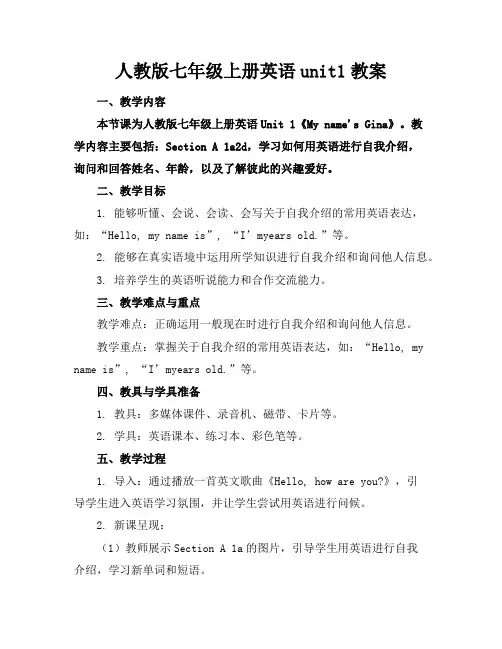
人教版七年级上册英语unit1教案一、教学内容本节课为人教版七年级上册英语Unit 1《My name's Gina》。
教学内容主要包括:Section A 1a2d,学习如何用英语进行自我介绍,询问和回答姓名、年龄,以及了解彼此的兴趣爱好。
二、教学目标1. 能够听懂、会说、会读、会写关于自我介绍的常用英语表达,如:“Hello, my name is”, “I’myears old.”等。
2. 能够在真实语境中运用所学知识进行自我介绍和询问他人信息。
3. 培养学生的英语听说能力和合作交流能力。
三、教学难点与重点教学难点:正确运用一般现在时进行自我介绍和询问他人信息。
教学重点:掌握关于自我介绍的常用英语表达,如:“Hello, my name is”, “I’myears old.”等。
四、教具与学具准备1. 教具:多媒体课件、录音机、磁带、卡片等。
2. 学具:英语课本、练习本、彩色笔等。
五、教学过程1. 导入:通过播放一首英文歌曲《Hello, how are you?》,引导学生进入英语学习氛围,并让学生尝试用英语进行问候。
2. 新课呈现:(1)教师展示Section A 1a的图片,引导学生用英语进行自我介绍,学习新单词和短语。
(2)教师播放1b的录音,学生跟读,学习正确的发音。
(3)学生两人一组,根据2a的提示,互相提问并回答关于姓名、年龄、兴趣爱好等问题。
3. 情景交际:(1)教师创设真实语境,引导学生运用所学知识进行自我介绍和询问他人信息。
(2)学生分角色进行角色扮演,模拟真实场景。
4. 例题讲解:(1)教师讲解一般现在时的用法,并结合例句进行展示。
(2)学生完成Section A 2b的练习,巩固一般现在时的用法。
5. 随堂练习:(1)学生完成Section A 2c的练习,进行听力训练。
(2)学生两人一组,根据2d的提示,互相提问并回答问题。
(1)教师邀请学生分享本节课的学习收获。
2024人教版七年级上册英语教案
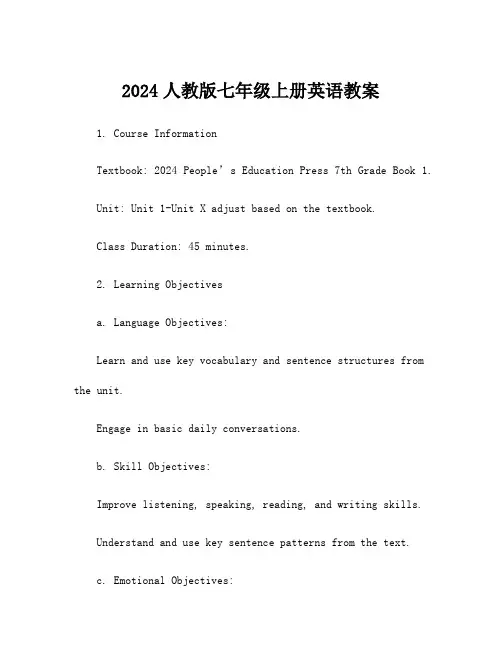
2024人教版七年级上册英语教案1. Course InformationTextbook: 2024 People’s Education Press 7th Grade Book 1.Unit: Unit 1-Unit X adjust based on the textbook.Class Duration: 45 minutes.2. Learning Objectivesa. Language Objectives:Learn and use key vocabulary and sentence structures from the unit.Engage in basic daily conversations.b. Skill Objectives:Improve listening, speaking, reading, and writing skills.Understand and use key sentence patterns from the text.c. Emotional Objectives:Foster interest and confidence in learning English.Enhance teamwork and communication skills.3. Lesson ContentText: Dialogues, short texts, and stories from the unit.Vocabulary: New words and phrases from the unit.Grammar: Key grammar points from the unit.Functional Sentences: Core sentences and expressions from the unit.4. Teaching Stepsa. Introduction (5 minutes)Use images, videos, or questions to introduce the lesson theme.Engage students and outline the learning objectives.b. New Content (15 minutes)Vocabulary: Introduce and explain new words, focusing on pronunciation, spelling, and meaning.Grammar: Explain key grammar points with examples.Sentence Patterns: Demonstrate core sentence structures and practice.c. Text Learning (10 minutes)Read the text aloud and discuss its content.Engage in group discussions or role-plays to practice dialogues.d. Practice (10 minutes)Complete related exercises such as fill-in-the-blanks, matching, and multiple-choice questions.Use group activities or games to reinforce vocabulary and sentence structures.f. Summary and Homework (5 minutes)Review the lesson’s content and address any student questions.Assign homework, such as vocabulary practice, writing tasks, or reading assignments.5. Homework AssignmentsVocabulary Practice: Complete exercises from the textbook.Writing Task: Write a short paragraph using the new vocabulary and sentence structures.Listening Exercise: Listen to recordings and complete related comprehension questions.6. AssessmentOral Evaluation: Assess student participation and performance in class.Written Evaluation: Evaluate homework and exercise accuracy.7. ReflectionReflect on the effectiveness of the lesson based on student feedback and observation.Note areas for improvement for future lessons.。
人教版七年级英语上册Unit1YouandMeSectionB1a1d教学设计
针对人教版七年级英语上册Unit1 You and Me Section B 1a-1d的内容,我对学情进行分析如下:
七年级学生正处于青春期,他们对新鲜事物充满好奇,学习积极性较高。在此基础上,学生已经具备了一定的英语学习基础,掌握了基本的字母、单词和简单句型。然而,他们对英语的实际运用能力仍有限,尤其在使用英语进行自我介绍和问候方面。
5.阅读一篇英文短文,关于友谊的主题,要求学生理解短文内容,并用英语写出自己的心得体会。
6.结合所学知识,编写一段对话,场景可以是学校、聚会等,要求运用本节课的核心词汇和重点句型。
作业布置要求:
1.作业量适中,确保学生能在规定时间内完成。
2.作业内容具有趣味性和实践性,激发学生的学习兴趣。
3.教师在批改作业时,关注学生的个体差异,给予针对性指导。
1.教师以一首英文歌曲《Hello》作为课堂导入,激发学生的学习兴趣,同时让学生在轻松愉快的氛围中感知英语语音、语调。
2.歌曲结束后,教师引导学生用英语进行自我介绍,如:“Hello, my name is…”,让学生在实际交流中复习巩固已学的英语知识。
3.教师通过提问方式引导学生思考:“How can we make new friends in English?”,从而引出本节课的主题——用英语进行自我介绍和问候。
3.任务型教学法,培养学生的合作意识:通过设置小组任务,引导学生进行合作学习,培养学生的团队协作精神和沟通能力。同时,教师应关注学生在任务中的表现,及时给予指导和鼓励。
4.利用多媒体教学资源,丰富课堂教学:教师可以运用图片、视频等教学资源,让学生在直观、生动的氛围中学习英语,提高他们的听说能力。
5.课后巩固,提高学习效果:教师应布置适量的课后作业,让学生在课后对所学知识进行巩固。同时,鼓励学生利用网络、课外读物等资源,拓展英语学习。
新人教版七年级英语上册教案Unit1
新人教版七年级英语上册教案Unit1教案概述本教案是针对新人教版七年级英语上册第一单元的教学安排。
本单元主要内容包括自我介绍、问候和道别的基本表达,以及个人信息的询问与回答。
教学目标1. 掌握并能正确运用自我介绍的句型。
2. 理解并能正确运用问候和道别的基本表达。
3. 能够询问和回答个人信息。
课时安排本单元教学安排为2课时。
第一课时课堂活动1. 导入:通过图片和问题引起学生对自我介绍的兴趣。
2. 呈现:教师呈现自我介绍的句型,帮助学生理解并学会运用。
3. 练:学生进行自我介绍练,并互相评价。
4. 拓展:教师向学生介绍不同国家的问候俗,进行讨论。
教学重点1. 自我介绍的句型。
2. 问候和道别的基本表达。
教学难点1. 自我介绍的运用。
2. 问候和道别的实际应用。
第二课时课堂活动1. 复:教师通过问题和游戏复第一课时所学内容。
2. 呈现:教师呈现个人信息的询问和回答的句型,并帮助学生掌握。
3. 练:学生进行个人信息的询问和回答练。
4. 拓展:教师引导学生探讨不同国家的个人信息俗。
教学重点1. 个人信息的询问和回答的句型。
2. 运用个人信息进行实际对话。
教学难点1. 实际运用个人信息进行对话。
2. 理解不同国家的个人信息俗。
教学评价本教案的教学评价将以学生在课堂上的参与度、语言表达能力和对内容的理解程度为主要评价指标。
参考资料1. 新人教版七年级英语上册教材。
2. 英语教学参考书。
人教版七年级英语上册Unit1单元教学设计
6.家长参与作业:鼓励家长参与学生的英语学习,家长与孩子一起完成一个家庭英语小任务,如制作英语菜单、进行家庭英语角等。
-通过这种方式,让家长了解孩子的学习进度,促进家校共育。
-例如,对学生的每一次尝试给予积极的反馈,表扬他们的进步,鼓励他们继续努力。
7.家校合作:与家长保持沟通,共同关注学生的学习情况,鼓励家长参与学生的学习过程,为学生提供一个良好的学习环境。
-例如,通过家长会或家访,向家长介绍学生的学习内容,教给家长一些简单的英语问候语,以便家长能在日常生活中与孩子用英语交流。
五、作业布置
为了巩固本单元的知识点,提高学生的英语实际运用能力,我设计了以下作业:
1.词汇练习:要求学生课后复习本节课所学的词汇,并尝试用这些词汇编写一段小对话,可以是学校生活中的场景,如上课、课间休息等,以加强学生对词汇的记忆与运用。
-提醒学生注意单词的拼写和发音,鼓励他们在日常生活中尝试使用这些词汇。
5.注重培养学生的自主学习能力,引导学生学会利用课外资源进行学习,拓展英语学习渠道。
三、教学重难点和教学设想
(一)教学重难点
1.重点:本单元的重点在于掌握基本的日常交流用语,如问候、介绍自己、询问他人状况等,并能在实际情景中灵活运用。
2.难点:对于七年级学生而言,正确使用一般疑问句和肯定回答结构进行对话,以及掌握字母书写的规范是学习的难点。
-建议学生多听多模仿,注意语音语调的把握。
4.课堂笔记整理:要求学生整理本节课的学习笔记,将所学词汇、语法点、常用句型等进行分类整理,形成自己的学习资料。
-鼓励学生用自己的方式整理笔记,便于课后 Nhomakorabea习和巩固。
人教版(2024)七年级英语上册Unit1YouandMeSectionA2a2e教案(表格式)
7
备课时间
月日
授课时间
月日
总节次
课题
GFI 7A Unit 1 You and Me Section A2a-2e(第三课时听说课)
教材分析
Text Analysis
What
Why
How
本语篇为发生在校园里的师生之间的对话。具体内容可能为Chen Jie与Peter Brown在校园里散步时遇见英语老师Mr Smith而展开的一段对话。首先是Chen Jie和Mr Smith打招呼和问候彼此,然后向Mr Smith介绍Peter Brown。然后Mr Smith询问Peter Brown的班级和班主任是谁。Peter Brown因记错班主任高老师的姓氏,Chen Jie及时纠正。
难点
Difficult
Points
1.With the help of common expressions, complete the dialogue exercises of 2e, imitate the role playing of the dialogue, and internalize the language.
通过巡视与聆听,判断学生能否正确的运用本节课的所学知识,流畅地介绍书中的思位主要人物。
通过巡视与聆听,评价学生的相互认识活动,并在过程中予以评价和反馈等。
设计意图
Design Intent
2e的学习活动旨在帮助学生巩固强化所学语言表达,为接下了的实际应用活动奠定坚实的基础。
推广相互介绍彼此的朋友。帮助同学们加快认识和了解彼此的速度,促进自己与朋友之间的友好交往,从而更好地适应新的学习环境。
Who’s your class teacher?It’sMsGao.
- 1、下载文档前请自行甄别文档内容的完整性,平台不提供额外的编辑、内容补充、找答案等附加服务。
- 2、"仅部分预览"的文档,不可在线预览部分如存在完整性等问题,可反馈申请退款(可完整预览的文档不适用该条件!)。
- 3、如文档侵犯您的权益,请联系客服反馈,我们会尽快为您处理(人工客服工作时间:9:00-18:30)。
3.重点句型。
学情分析
教学方法
任务型教学、分级评价法、直观教学法、模仿示范法、情景教学和合作学习法
学习方法
课前预习、课堂内外练习、听说读写结合
教学过程设计
备注
课题引入
I. Warming- up and revision
1.Sing ABC song.
2.Greeting (Say hello between the teacher and the Ss)
新人教版七年级上册英语教案Unit.1
Unit 1 My name’s Gina.
授课班级
授课日期
授课类型
新授课
学时数
The 1st period ( Section A 1a—1c)
教学目标
1.Get students to learn how to greet people, introduce themselves and make new friends.
V. Listening drills (2)
1.Do Section A, 2a. Listen to four conversations and number the pictures (1-4).
2.Do Section A, 2b. Listen again, circle the names according to the tape.
教学内容
New words:his, and, her, question, answer, look
-- What’s your/his/her name?
-- My/His/Her name is ……
重点难点
1、了解英语与汉语中姓与名的位置不同,准确掌握英语的姓与名的表达;
2、听懂并能说出电话号码,培养学生的英语意识。
2.Teach students to say English names in the right way.
3.Get students to ask for and give telephone numbers.
教学内容
New words:name, clock, am, nice, meet, what, hello
His name /Her name is ……
I think his/her name is…
Is he/she……?
III. Summary (short forms)
Teach the students “’s” is short for “is” and “m” is short for “am”, then do the following exercises:
Listen for the last time, then fill in the blanks.
小结与作业
课堂小结
本课作业
1.Listen and read after the tape for thirty minutes.
2.Recite the first conversation of Section A, 2c.
III. Listening drills (1)
1.Do Section A, 1b, listen and number the conversations (1-3).
2.Show the picture on page 1 on the screen with no words on it. Get student to listen to the tape and try to repeat the sentences in the conversations, each correct sentence will earn a point for the group.
课堂练习
IV. Pair-work.
1.Get the students listen to the conversations again and repeat after the tape, then work in groups, practice the conversations with the partners.
S1: I’m Xu Dong./My name is… Nice to meet you.
T: Nice to meet you ,too.
(Then S1 turn around and greet S2 in the same way.)
教学步骤
及
主要内容
II. Presentation
1.T: Boys and girls, let’s play a guessing game, “What’s his/her name?” OK?
4.Review introduction
Play the “Word train” game. Get a group of students ask and answer questions one by one.
T: Good morning. I’m Diana.What’s your name?
重点难点
1.会拼读生词和问姓名的句型。2.注意中英文姓名的差别。
学情分析
教学方法
任务型教学、分级评价法、直观教学法、模仿示范法、情景教学和合作学习法
学习方法
课前预习、课堂内外练习、听说读写结合
教学过程设计
备注
课题引入
I. Warming-up and revision
1. Play the tape, enjoy the ABC song or Hello song, get the Ss to sing together.
2. Divide the class into Group A and B. Draw two fishes on the blackboard as their symbols, tell the students that each time they answer questions right, they can get one or more points for their group and draw one or more bubbles around their fish, at the end of the class, the group which gets more bubbles will be the winner today. Say, “One, two, three!” Get the whole class sit straight, thus announce the beginning of the competition.
3.Do Section A, 1a. First, have the students work in groups, write down as many words as possible on their students’ books in only 2 minutes; then get a student from each group to write down their words on the blackboard at the same time, the one who writes more can get more points.
3.Write down the Chinese meaning of the new words and key sentences, then translate them into English.
本课教学后记(课堂设计理念,实际教学效果及改进设想)
Unit 1 My name’s Gina.
教学步骤
及
主要内容
II. Presentation
1.Teacher says: , “Hello!Myname is Lily.What’syourname?” Get the students teacher says, “It’s a good / nice name. I like your name.”
2.On the screen show a lovely mouse saying “My name’s Gina.” Underline “My name’s”, tell the students it means “My name is/ I am/ I’m”.
3.Show the question “What’s your name?” Underline “What’s”, tell the students that it means “What is”.
3. Revise the three units in Starters. Show some key sentences in Chinese on the screen, have students translate them into English, get a student from each group to come to the front and write down their answers on the blackboard, then check the answers, each correct sentence will earn a point for the group.
